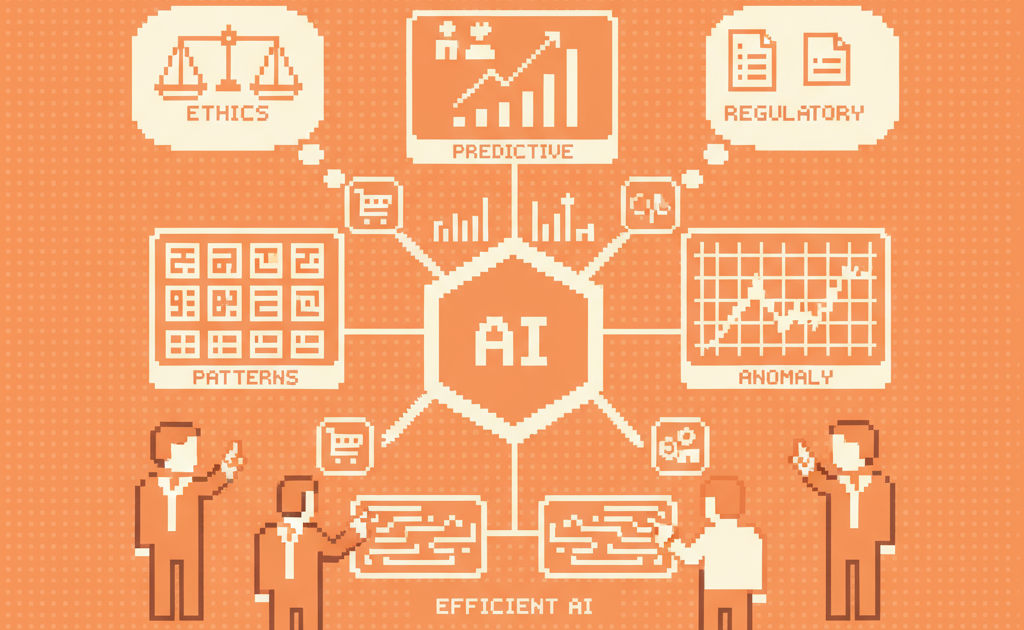AI and Data Analytics: Essential Insights
AI revolutionizes data analytics with insights, trends, and ethical challenges for 2025.

AI Revolutionizing Data Analytics
Artificial intelligence (AI) is transforming data analytics by processing vast, complex datasets at speeds unattainable by humans alone. This fusion enables organizations to gain faster, more precise insights, crucial for decision-making in a data-saturated landscape.
At its essence, AI encompasses systems that mimic human intelligence through tasks like pattern recognition and learning from data. In data analytics, machine learning algorithms evolve without explicit instructions, while natural language processing interprets human language. Generative AI generates content from training data, enhancing predictive modeling and anomaly detection.
AI excels at analyzing unstructured sources, such as social media or customer feedback, revealing sentiments and trends overlooked by conventional approaches. Predictive analytics, for example, forecasts behaviors from historical patterns, supporting strategic business planning. The International Institute of Business Analysis notes that AI automates routine tasks, freeing analysts for higher-level interpretation IIBA Blog on AI in Data Analysis.
As AI advances, it democratizes sophisticated analytics, extending access beyond elite teams. This shift boosts efficiency and drives evidence-based decisions across sectors.
Core AI Technologies
Machine learning and deep learning form the pillars of AI in data analytics, enabling the extraction of insights from massive datasets to enhance decision-making and operations. Machine learning identifies patterns algorithmically, while deep learning processes intricate, multidimensional data via neural networks, powering predictive modeling, anomaly detection, and real-time analysis.
Machine Learning Algorithms
Machine learning algorithms underpin AI-driven data analytics, enabling pattern detection and predictions sans manual coding. Supervised learning trains on labeled data for classification or regression, such as forecasting customer churn from sales records. Unsupervised learning reveals structures in unlabeled data via clustering, ideal for market segmentation. Reinforcement learning refines actions through rewards, as in adaptive pricing systems.
These methods automate forecasting and recognition, as outlined in GeeksforGeeks on supervised, unsupervised, and reinforcement learning. They facilitate scalable business intelligence by handling large-scale data efficiently.
Deep Learning Frameworks
Deep learning employs neural networks to process unstructured data, a cornerstone of contemporary AI analytics. These networks hierarchically analyze inputs: initial layers capture basics, deeper ones complex patterns. This suits images, text, and audio where traditional tools struggle.
Convolutional neural networks (CNNs) excel in visual analytics like surveillance object detection, while recurrent neural networks (RNNs) manage sequences for forecasting. Frameworks such as TensorFlow and PyTorch streamline development, automating feature extraction. As per deep learning's handling of unstructured data, this improves accuracy in natural language processing and classification.
Deep learning thus manages big data's scale and diversity, spurring innovations in healthcare and finance.
Practical Applications
AI elevates data analytics through applications that convert raw data into strategic intelligence, including predictive modeling, anomaly detection, and automated insights, streamlining operations industry-wide.
Predictive Analytics
Predictive analytics harnesses AI to project trends from historical data, informing decisions across fields.
In retail, recommendation systems analyze purchases for tailored suggestions, increasing sales. Demand models factor in promotions and seasons to optimize inventory. Akkio explains how these prevent overstocking.
Finance uses it for credit scoring, integrating applicant details with economic data to curb defaults. Manufacturing applies predictive maintenance via sensor monitoring, reducing downtime by 70% and costs by 20%.
In public planning, AI projects population shifts for infrastructure. Time-series models like ARIMA handle trends, per Investopedia, yielding dependable forecasts.
This mitigates risks and spots opportunities, cementing AI's role in planning.
Anomaly Detection
Anomaly detection flags outliers in data, vital for fraud and quality assurance. AI learns norms and alerts on deviations for swift action.
Banks deploy machine learning to catch odd transactions, like unusual high spends, curbing losses via alerts Fraud.com.
E-commerce monitors logins to thwart takeovers. Healthcare spots billing errors or aberrant vitals for compliance.
Manufacturing scans sensors for defects using isolation forests to isolate anomalies efficiently.
These uses automate insights, from forecasts to alerts, promoting secure operations.
Emerging Trends 2025
By 2025, AI-data analytics intersections will feature efficient models, wider adoption, and stricter regulations, broadening access and responsibility.
Efficient AI Models Driving Scalable Analytics
Model efficiency gains lower entry barriers for analytics. Stanford's 2025 AI Index reports GPT-3.5-level inference costs fell over 280-fold from 2022-2024, with hardware down 30% yearly and energy up 40%. Open models nearly match closed ones. This enables edge-device simulations, aiding real-time finance and healthcare decisions without heavy cloud reliance.
Surging Business Adoption in Data Analytics
AI adoption surges, enhancing analytics. 78% of firms used AI in 2024, up from 55%, with U.S. investments at $109.1 billion. PwC notes 49% embed AI strategically, yielding 20-30% productivity boosts. AI agents handle data prep, freeing focus for insights; generative AI halves R&D cycles.
Global Regulatory Shifts Shaping Responsible Practices
Regulations grow for ethical AI. The AI Index cites 59 U.S. rules in 2024, doubled prior, with 21.3% global rise. OECD, EU, U.N. stress transparency. For analytics, this requires privacy and bias controls in marketing or policing. PwC links ROI to responsible practices, with 46% executives prioritizing ethics. Compliance tools ensure trust amid evolving rules.
Challenges and Considerations
-
AI integration in data analytics poses hurdles demanding careful handling for ethics and efficacy.
-
Algorithmic bias risks unfair results, like biased hiring, from skewed datasets. Solutions include diverse data and audits.
-
Privacy strains under vast personal data use, challenging consent and risking re-identification per GDPR GDPR. Privacy-by-design is essential.
-
Black-box models obscure reasoning, eroding trust in diagnostics. Explainable AI (XAI) promotes transparency.
-
Interdisciplinary approaches blend tech, ethics, and governance for dependable practices.
Future of AI Analytics
AI's evolution will revolutionize data value extraction via precise models and automation. Adoption grows with $109.1 billion U.S. investments in 2024, boosting productivity.
Efficiency rises as small models rival large ones, costs plummet, and investments expand. Regulations ensure responsibility.
Prioritizing ethics and learning unlocks real-time intelligence. Stanford's 2025 AI Index Report forecasts industry reshaping with balanced innovation.
Written by Elias Vance
Ready to build your next AI app?